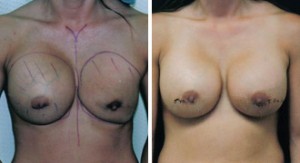Ruptured Breast Implants
Posted On: January 30, 2009 Author: The Office of Dr. Stuart Linder Posted In: Home
 Patients present to us in Beverly Hills / Hollywood for ruptured breast implants every week. Ruptured implants can occur for many reasons. They can occur due to trauma, blunt trauma, such as a seatbelt whiplash accident or even being assaulted. It can also occur simply due to wear and tear of an implant.
Patients present to us in Beverly Hills / Hollywood for ruptured breast implants every week. Ruptured implants can occur for many reasons. They can occur due to trauma, blunt trauma, such as a seatbelt whiplash accident or even being assaulted. It can also occur simply due to wear and tear of an implant.
Smooth versus textured implants have different rates of rupture. The textured implants have a significantly higher rate of rupture because they develop fold creases within the shell, which will adhere to the tissue surrounding it and the capsule and with time will crack and leak. As a result, we prefer not to use textured implants any longer. Smooth implants can rupture as well. Rupturing can occur anywhere within the implant bag, the valve can leak or a small pinpoint rupture can occur along the circumferential periphery of the implant edge.
In any case, what do you do when you have determined that you have a ruptured implant? Saline implant ruptures are clinically obvious. The implant will completely deflate and the breast will look completely smaller and asymmetric from the other side. This should be taken care of as soon as possible because as the implant continues to deflate, scar tissue will trap and reduce the volume size of the pocket, causing collapse of the pocket. An open capsulotomy versus possible capsulectomy with implant removal and replacement should be done as soon as possible under general anesthesia. Only Board Certified Plastic Surgeons should do these operations in a Medicare and State Licensed Facility with a Board Certified Anesthesiologist, under general anesthesia.
Silicone ruptures can be silent in that they may not even be noticeable for many years and that the breast size may not reduce in size at all. MRI’s should be done whenever there is thought of a rupture or every two to three years per FDA requirements as of November 2006. Just as with saline, silicone implant ruptures should be immediately addressed. Now, silicone implant ruptures can lead to calcifications, silicone granulomas and silicone gel leakage to the axilla or other lymph nodes within the body and therefore should be immediately addressed surgically.